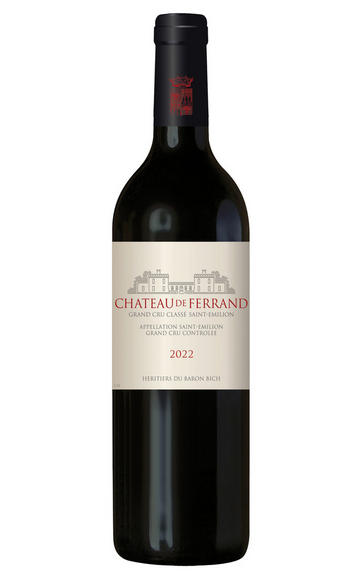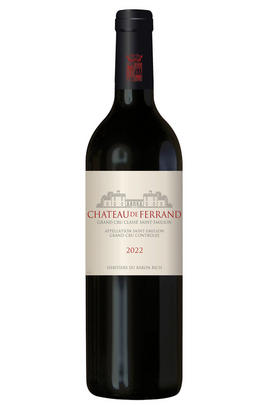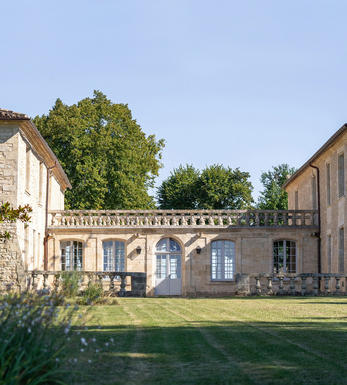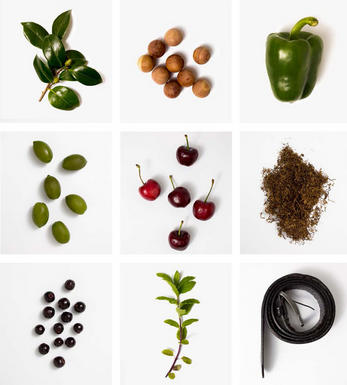
2022 Château de Ferrand, St Emilion, Bordeaux

Critics reviews
Concentrated damson colour, perfumed floral aromatics, brushed velvet tannins, hit of baked cherry, peach pit and bitter chocolate gives a lovely tension and lift alongside the intense ripe fruit flavours. Tannins are elongated, with grip, and this has plenty of personality and balance, takes the imprint of the vintage but gives it a limestone twist, and will age extremely well.
Family Bich. Axel Marchal consultant since 2019, 32.1ha, 32% new oak, plus 4% terracotta amphora. Around 80% of 1st wine. 3.65ph. 2022 marks the second year of Château de Ferrand’s organic conversion, and is the earliest-ripening vintage in the estate’s history, with harvest stretching from September 5 to October 5. Gonzague de Lambert director.
Jane Anson, JaneAnson.com (May 2023)
66% Merlot, 34% Cabernet Franc. Cask sample.
Not the deepest crimson. Super-ripe rather than fresh on the nose. Thick and sweet with some slightly green tannin on the end.
Drink 2027 - 2037
Jancis Robinson MW, JancisRobinson.com (May 2023)
Smells intense and inviting. Smooth and supple on the palate, creamy, sweet, tangy and cool fruit enters the palate - blueberries, raspberries, cherries and blackcurrants alongside clear minerality in the salty, liquorice, graphite and flint edge. Tannins are well-worked and precise and do well to give the frame and structure.
The juicy core is lovely and has some compelling aspects in the minerality, crunchy, pure fruit and just spiced clove, cinnamon and tobacco edges. Feels nicely complete with purpose. A touch sombre, but I like the seriousness. Harvest 5 September-5 October. Yield of 44hl/ha. 3.65pH.
Drink 2026 - 2046
Georgina Hindle, Decanter.com (April 2023)
In the same league as the 2020, if not better, the 2022 Château De Ferrand offers an incredibly pure, balanced, and structured style with its first-rate aromatics of red and black fruits, chocolate, crushed stone, and graphite. Medium to full-bodied on the palate, with fine-grained yet building tannins, it will warrant at least short-term cellaring, but the quality is there.
Jeb Dunnuck, JebDunnuck.com (May 2023)
About this WINE

Château de Ferrand
Château de Ferrand sits in one single block at one of St Emilion’s highest points, a clay and limestone plateau in the commune of St Hippolyte. Until recently, the wines were not offered En Primeur; the property is perhaps lesser known than it should be as a result. But that is changing.
The estate belongs to the Bich family, makers of the four-colour Bic pens that every French schoolchild knows all too well. Today, Pauline Bich and her husband Philippe Chandon-Moët (a Champagne native, evidently), run the estate. Under their watch, it became a Grand Cru Classé in 2012. The talented Gonzague de Lambert, formerly of Viña Vik in Chile and whose family own Château de Sales in Pomerol, is the general manager and winemaker. Axel Marchal, one of Bordeaux’s leading young consultants, advises here. There is an ever-greater focus on Cabernet Franc, representing almost 30% of the vineyard today.
The 2022 vintage marks the estate’s second in its three-year conversion to organic certification. This is a smart château with a sophisticated hospitality setup, including qualified sommeliers on staff, an in-house chef and an enviable (pen-themed) art collection. Ferrand might be a relative newcomer to En Primeur, but it is an estate on the rise and worth seeking out.

St Émilion
St Émilion is one of Bordeaux's largest producing appellations, producing more wine than Listrac, Moulis, St Estèphe, Pauillac, St Julien and Margaux put together. St Emilion has been producing wine for longer than the Médoc but its lack of accessibility to Bordeaux's port and market-restricted exports to mainland Europe meant the region initially did not enjoy the commercial success that funded the great châteaux of the Left Bank.
St Émilion itself is the prettiest of Bordeaux's wine towns, perched on top of the steep limestone slopes upon which many of the region's finest vineyards are situated. However, more than half of the appellation's vineyards lie on the plain between the town and the Dordogne River on sandy, alluvial soils with a sprinkling of gravel.
Further diversity is added by a small, complex gravel bed to the north-east of the region on the border with Pomerol. Atypically for St Émilion, this allows Cabernet Franc and, to a lesser extent, Cabernet Sauvignon to prosper and defines the personality of the great wines such as Ch. Cheval Blanc.
In the early 1990s there was an explosion of experimentation and evolution, leading to the rise of the garagistes, producers of deeply-concentrated wines made in very small quantities and offered at high prices. The appellation is also surrounded by four satellite appellations, Montagne, Lussac, Puisseguin and St. Georges, which enjoy a family similarity but not the complexity of the best wines.
St Émilion was first officially classified in 1954, and is the most meritocratic classification system in Bordeaux, as it is regularly amended. The most recent revision of the classification was in 2012

Cabernet Sauvignon
The most famous red wine grape in the world and one of the most widely planted.
It is adaptable to a wide range of soils, although it performs particularly well on well-drained, low-fertile soils. It has small, dusty, black-blue berries with thick skins that produce deeply coloured, full-bodied wines with notable tannins. Its spiritual home is the Médoc and Graves regions of Bordeaux where it thrives on the well-drained gravel-rich soils producing tannic wines with piercing blackcurrant fruits that develop complex cedarwood and cigar box nuances when fully mature.
The grape is widely planted in California where Cabernet Sauvignon based wines are distinguished by their rich mixture of cassis, mint, eucalyptus and vanilla oak. It is planted across Australia and with particular success in Coonawarra where it is suited to the famed Terra Rossa soil. In Italy barrique aged Cabernet Sauvignon is a key component in Super Tuscans such as Tignanello and Sassicaia, either on its own or as part of a blend with Sangiovese.


Buying options
Add to wishlist
Description
Although owned by the Bich family (of Bic pens fame) since 1978, only relatively recently has this estate has begun to move through the gears. The property is smartly positioned on the limestone ridges that fan out to the east of the town of St Emilion. Its move towards certified organic status and the arrival of Axel Marchal as consultant in 2018 suggest the stars are aligning.
There is investment too in the new cellars, opened in 2019. The 2022 certainly shows promise: there are good notes of ripe damson, and the palate is full and chocolatey with layers of limestone firmness to match the fullness of the vintage. This is a château clearly on the right path and is one of our “five to watch” this year.
Blend: 66% Merlot and 34% Cabernet Franc
Drink 2027 - 2042
Score: 16.5/20
Berry Bros. & Rudd (April 2023)
wine at a glance
Delivery and quality guarantee